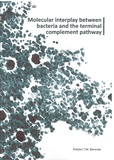Molecular interplay between bacteria and the terminal complement pathway

Berends, Evelien
- Promoter:
- Prof.dr. J.A.G. (Jos) van Strijp
- Co-promoter:
- Dr. S.H.M. (Suzan) Rooijakkers
- Research group:
- Rooijakkers , Strijp
- Date:
- May 7, 2015
- Time:
- 00:00 h
Summary
The plasma proteins of the complement system fulfill important immune defense functions, including opsonization of bacteria for phagocytosis, generation of chemo-attractants and direct bacterial killing via assembly of the Membrane Attack Complex (MAC or C5b-9 complex). The terminal complement pathway is the final stage of the complement cascade. This pathway is initiated by surface-bound C5 convertase enzymes that cleave C5 into C5b. The formation of C5b leads to rapid assembly of the MAC that perturbs lipid bilayers. The MAC can kill Gram-negative bacteria whereas Gram-positive bacteria are resistant.
In this thesis we discovered that the MAC can kill Gram-negative bacteria at different rates and that the bactericidal activity of serum can be both dependent on MAC assembly and other serum components. Some Gram-negative pathogens have evolved MAC evasion strategies, of which we described a secreted MAC-inhibitor from Pseudomonas aeruginosa. Even though Gram-positive bacteria are intrinsically resistant against MAC-mediated killing, we found specific deposition and distinct localization of C5b-9 complexes on this class of bacteria. Since C5 convertases are crucial for the initiation of MAC assembly, our newly established convertase model systems allowed us here to gain detailed insights into the final steps of complement activation on both the Gram-positive as well as the Gram-negative surface.